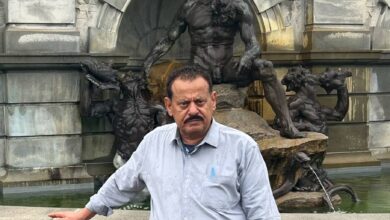Our Ancestors from Hadhramout

Yemeni mp
Ahmed Saif Hashed
Our villages are scattered across the valleys and perched atop high mountains. Some have attempted to climb even higher, while others have nestled closer to the valleys. Our villages reflect the resilience of their inhabitants—men, women, and children alike. How did we come to be here? From where did we originate? How did our ancestors reach this place hundreds of years ago?
It is said that our grandfather journeyed from Hadhramout to the area of “Al-Qabayta” more than three hundred years ago. He was known as “Sheikh Huyay,” accompanied by his uncle “Sheikh Ahmed,” along with one or more servants. We are uncertain if there were other men in their company, or whether Hawwa (Eve) was among them or counted among the newcomers.
Both names carry the title of “Sheikh,” likely due to their esteemed social and religious status. My mother is connected to “Sheikh Huyay,” while my father is linked to Sheikh Ahmed. Notably, more attention is given to the shrine of “Sheikh Huyay” than to that of “Sheikh Ahmed.” I have sought blessings from the soil of my maternal grandfather’s grave, but I have not sought blessings from my paternal grandfather’s grave. This distinction warrants further exploration.
Yet, the question persists: what compelled our ancestors to leave the comforts of Hadhramout and its kind people to venture into this remote, challenging territory, perhaps even sparsely populated? How could they abandon Hadhramout, passing through countless places on a journey that stretched nearly a thousand miles, only to settle in a distant, unknown region devoid of allure or worthiness for such an undertaking?
What motivated these ancestors to forsake the land and sea of Hadhramout, its plains and beaches, and its inhabitants? They traversed a long journey filled with diverse environments and populations, many of which were far more enticing than the areas where they ultimately settled. How did they cover a distance that might have taken months on their camels, only to end up in isolated regions far from their families, establishing their homes on high mountains before gradually moving downward?
One day, I asked my mother about the reason for this migration. She told me she had heard they came from Hadhramout seeking a fatwa (religious edict). This revelation puzzled me even further! Our regions lacked scholars and were not renowned for knowledge or fatwas; there were not many people at that time. In fact, perhaps the monkeys outnumbered the inhabitants. Did they come to impart some knowledge of law and inheritance to the sparse population of the areas they reached?
Were there political or social reasons, acts of oppression, pursuit by authorities, or instability that compelled them to leave Hadhramout and head far away to fortified, remote areas, resistant to those who might seek to pursue or impose authority upon them? Was the choice of these regions as their new home motivated by the safety and peace they offered? Or were our areas, three hundred years ago, lush meadows and thickets, abundant with water, drawing those in search of a better life to settle there?
These are questions that require investigation to uncover the truth or arrive at a convincing explanation for what transpired.
* * *






